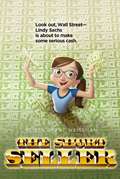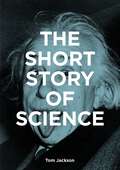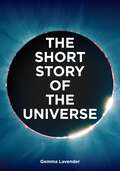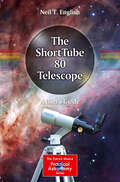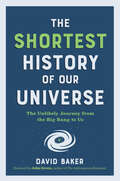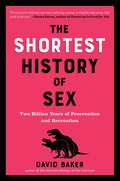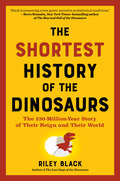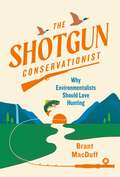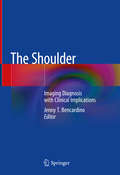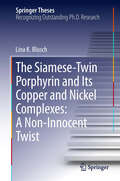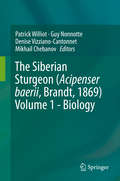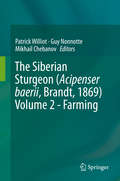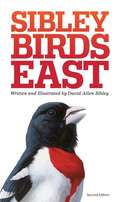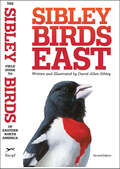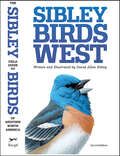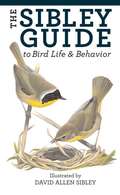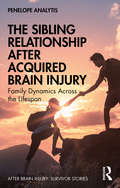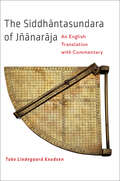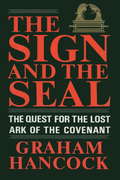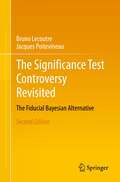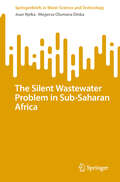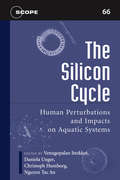- Table View
- List View
The Short Seller
by Elissa Brent WeissmanLook out Wall Street--Lindy Sachs is about to make some serious cash. A twelve-year-old takes on the stock market in this money-minded middle grade novel. It all starts when seventh grader Lindy Sachs is granted $100 and access to her father's online trading account as a way to alleviate her boredom while she's home sick from school. Lindy learns something immediately--she is very, very good at e-trading. Her $100 becomes $200. Then $400. And more. With trading talent and access to her parents' savings, the opportunity to make some real dough is too tempting to pass up. In fact, given how well Lindy's stocks are doing, it would be a disservice to not invest it all... Right?
The Short Seller
by Elissa Brent WeissmanA twelve-year-old takes on the stock market in this money-minded middle grade novel that Publishers Weekly calls "a smart pick."It all starts when seventh grader Lindy Sachs is granted one hundred dollars and access to her father's online trading account as a way to alleviate her boredom while she's home sick from school. Lindy learns something immediately--she is very, very good at e-trading. Her one hundred dollars soon becomes two hundred dollars. Then four hundred. And more. With trading talent and access to her parents' savings, the opportunity to make some real dough is too tempting to pass up. In fact, given how well Lindy's stocks are doing, it would be a disservice to not invest it all...Right?
The Short Story of Science: A Pocket Guide to Key Histories, Experiments, Theories, Instruments and Methods
by Tom Jackson Mark Fletcher'Nothing in life is to be feared. It is only to be understood. Now is the time to understand more, so that we may fear less' Marie CurieThe Short Story of Science is a new introduction to the complete subject of science. Covering 60 key experiments, from Archimedes' investigations of buoyancy to the discovery of dark matter, and then linking these to the history of science, as well as to the key theories and methods, the book simplifies and explains all the key breakthroughs.Accessible and concise, generously illustrated throughout, and with all the essential information presented without jargon, readers are given all the tools they need to enjoy the fascinating history of scientific knowledge.
The Short Story of Science: A Pocket Guide to Key Histories, Experiments, Theories, Instruments and Methods
by Tom Jackson Mark Fletcher'Nothing in life is to be feared. It is only to be understood. Now is the time to understand more, so that we may fear less' Marie CurieThe Short Story of Science is a new introduction to the complete subject of science. Covering 60 key experiments, from Archimedes' investigations of buoyancy to the discovery of dark matter, and then linking these to the history of science, as well as to the key theories and methods, the book simplifies and explains all the key breakthroughs.Accessible and concise, generously illustrated throughout, and with all the essential information presented without jargon, readers are given all the tools they need to enjoy the fascinating history of scientific knowledge.
The Short Story of the Universe: A Pocket Guide to the History, Structure, Theories and Building Blocks of the Cosmos
by Mark Fletcher Gemma LavenderThe Short Story of the Universe is a new introduction to the subject of the universe. Covering 130 key components that make it up - from dwarf galaxies and spiral arms to red giants and the planets of the solar sytem - and linking these to the universe's structure and the theories that help us understand it, this book simplifies this riveting yet mind-boggling subject, telling the story of how it came into being and how it will eventually be no more. Accessible and concise, generously illustrated throughout, and with all the essential information presented without jargon, readers are given all the tools they need to enjoy the fascinating history of the deepest depths of the universe.
The Short Story of the Universe: A Pocket Guide to the History, Structure, Theories and Building Blocks of the Cosmos
by Mark Fletcher Gemma LavenderThe Short Story of the Universe is a new introduction to the subject of the universe. Covering 130 key components that make it up - from dwarf galaxies and spiral arms to red giants and the planets of the solar sytem - and linking these to the universe's structure and the theories that help us understand it, this book simplifies this riveting yet mind-boggling subject, telling the story of how it came into being and how it will eventually be no more. Accessible and concise, generously illustrated throughout, and with all the essential information presented without jargon, readers are given all the tools they need to enjoy the fascinating history of the deepest depths of the universe.
The ShortTube 80 Telescope: A User's Guide (The Patrick Moore Practical Astronomy Series)
by Neil T. EnglishWelcome to the first comprehensive guide to one of the world’s most popular telescopes: the ShortTube 80 refractor. With its ultra-portability, versatility, and relatively low cost, this telescope continues to delight generations of stargazers.Starting in the field under a dark sky, the author walks the reader through a typical evening of stargazing, where the ShortTube 80 brings many astronomical treasures into focus. From there, he provides an in–depth account of the optical properties of the ShortTube 80 refractor and the accessories and mounting arrangements that maximize its potential both as a spotting ‘scope by day and an astronomical ‘scope by night.The main text discusses how the versatile ShortTube 80 can be used to study deep sky objects, the Sun, the Moon, bright planets and even high-resolution projects, where the instrument's features can be optimized for the observation of tight double and multiple stars. It explores how the ShortTube 80 can image targets using camera phones, DSLRs and dedicated astronomical CCD imagers.Packed with practical advice gained from years of firsthand stargazing experience, this book demonstrates exactly why ShortTube 80 has remained a firm favorite among amateur astronomers for over three decades, and why it is likely to remain popular for many years to come.
The Shortest History of Our Universe: The Unlikely Journey From The Big Bang To Us (Shortest History #0)
by David BakerA complete history of the universe, spanning 13.8 billion years in an ultra-accessible, uncommonly illuminating, exhilarating chronicle of key events “Baker introduces us not only to the history of our species and our planet, but the history of our vast universe.”—from the foreword by John Green, author of The Anthropocene Reviewed and The Fault in Our Stars In this thrilling history, David Baker captures the longest-possible time span—from the Big Bang to the present day—in an astonishingly concise retelling. His impressive timeline includes the “rise of complexity” in the cosmos and the creation of the first atoms; the origin of all galaxies, stars, and our solar system; and the evolution of life on Earth, from tiny single-celled organisms to human beings. Weaving together insights across the sciences—including chemistry, physics, biology, archaeology, and anthropology—Baker answers the fundamental questions: How did time begin? Why does matter exist? What made life on Earth the way it is? He also argues that never before has life on Earth been forced to adjust to a changing climate so rapidly, nor has one species ever been responsible for such sudden change. Baker’s grand view offers the clearest picture of what may come next—and the role we can still play in our planet’s fate.
The Shortest History of Sex: Two Billion Years Of Procreation And Recreation (Shortest History #0)
by David BakerA wild—and satisfying!—ride through two billion years of sexual evolution. The Shortest History books deliver thousands of years of history in one riveting, fast-paced read. From the first microbial exchanges of DNA to Tinder and sexbots, how did sex begin, and how did it evolve to be so varied and complex in humans? What influence do our genetic ancestors have on our current love lives? And what might sex look like in the future? With acuity, humor, and respect for human diversity, The Shortest History of Sex reveals where the many facets of our sexuality—chemical, anatomical, behavioral, social—come from. Chasing down our evolutionary family tree, from the first aquatic creatures to primate societies, David Baker sheds light on our baffling array of passions, impulses, and fetishes, and guides us toward a clear understanding of one of the deepest, most abiding forces of human nature. The Shortest History of Sex also charts how sex changed for humans across the foraging, agrarian, and modern eras, showing how, even as our biology and sexual instincts have remained the same, the current nature of our sex lives has no historical or evolutionary precedent. The result is a revealing, utterly unique insight into history and human behavior—and the profound forces of nature and nurture compelling our most intimate relationships.
The Shortest History of the Dinosaurs: The 230-Million-Year Story of Their Time on Earth (The Shortest History Series)
by Riley BlackA highlight-reel history of the dinosaurs, told like never before—bringing their world to vivid life in a paleontological detective story The Shortest History of the Dinosaurs tells the 230-million-year epic of these staggeringly fascinating prehistoric creatures, covering their small beginnings, spectacular golden periods, and stunning evolutionary success—before an unthinkable asteroid event brought everything to a screeching halt. But this history digs deeper, using numerous recent fossil discoveries and fresh understandings of genetics and evolution to show how we’ve gleaned so much about a long-lost world from mere fragments of fossil. Marshaling the evidence, award-winning author Riley Black reveals the startling relationships that dinosaurs shared with one another, the land they lived on, and other animal species. By conjuring a more complete picture of Earth in the age of the dinosaurs, she shows us how these massive monsters owe their rise to luck as much as to their cunning—and the many surprising ways they left an indelible mark on their dramatically changing world.
The Shotgun Conservationist: Why Environmentalists Should Love Hunting
by Brant MacDuffAt the intersection of hunting and conservation, a man shares his personal journey from staunch anti-hunter to compassionate, ethical hunter, weaving together a larger history of humans, animals, the environment, and our food systems.The Shotgun Conservationist doesn&’t teach us how to hunt, it explores why we should hunt. As public lands remain imperiled, factory farms pollute the earth and subject animals to inhumane conditions, and global uncertainty presses us all to be more self-sufficient, there has never been a better time to take up hunting. Writer, natural historian, and public speaker Brant MacDuff has done just that. An avid animal lover and raised as a non-hunter, MacDuff started his journey intending to investigate the claim that &“hunting is conservation.&” So convinced, he now holds a hunting license in four states and gives lectures on the positive impact it has on conservation efforts nationwide. Armed with years of experience in the field and a deep love for the natural world, MacDuff tells the provocative, humorous, and insightful story of how he became a hunter. Along the way, readers meet a cast of colorful characters and learn the firsthand research that helped change Brant&’s mind. You may not book a hunting trip after reading The Shotgun Conservationist, but you&’ll have a new perspective on and appreciation for those that do.
The Shoulder: Imaging Diagnosis with Clinical Implications (The\clinics: Radiology Ser. #20-2)
by Jenny T. BencardinoThis book covers all aspects of imaging diagnosis of shoulder disorders from a clinical perspective. After discussion of relevant imaging techniques, a wide spectrum of disorders is addressed in a series of dedicated chapters on rotator cuff injuries and impingement syndromes, biceps tendon and rotator interval pathology, glenohumeral instability, SLAP tears and microinstability, shoulder girdle fractures, shoulder arthropathies, tumors and tumor-like conditions, and entrapment neuropathies. Separate consideration is also given to the pediatric shoulder and to preoperative planning, postoperative imaging, and surgical techniques in patients undergoing shoulder arthroplasty.The unique anatomy and range of motion of the shoulder joint can present a diagnostic challenge. Characterization of soft tissue injuries and radiographically occult osseous pathology is often facilitated by the use of advanced imaging techniques, including MRI, CT, and ultrasound. Readers will find this excellently illustrated book to be an invaluable aid to diagnostic interpretation when employing these techniques.
The Siamese-Twin Porphyrin and Its Copper and Nickel Complexes: A Non-Innocent Twist
by Lina K. BluschThis thesis describes the first and long-sought successful synthesis of a new pyrazole-expanded porphyrin, a higher analog of porphyrin. This "Siamese-Twin Porphyrin" provides two conjoined porphyrin-like coordination spheres, thus being able to accommodate two metal ions within the same ligand. In her thesis, Lina Blusch not only explains the challenging synthesis and characterization of the ligand system, but also its application to the synthesis of homo- and hetero-bimetallic Ni and Cu complexes. She observes interesting metal-metal-interactions in the complexes, that lead to a non-innocent multistep redox chemistry. The ligand system and its complexes show an intriguing twisted geometry, giving rise to helical chirality and other fascinating properties. This study explores the first steps and opens up a new chemistry of expanded porphyrins with the potential to biomimetic applications.
The Siberian Sturgeon (Acipenser baerii, Brandt, 1869) Volume 1 - Biology
by Patrick Williot Guy Nonnotte Denise Vizziano-Cantonnet Mikhail ChebanovThe biology of the Siberian sturgeon, Acipenser baerii Brandt 1869, has become a very attractive subject of investigation for biologists since the 1980s. This volume 1 is part of a two-volume set devoted to the species, the second of which focuses on farming. The present volume is divided into three parts: Biology and ecology, Biology and physiology of reproduction, and Ecophysiology, i.e. adaptation to the environment. The first part addresses a broad range of topics, such as: the ecology, including a new approach to species-specificity, a new insight on the mineralization of vertebral elements, two approaches to sex determination, transposable elements in the gonads, early ontogeny, olfaction and gustation, nutrition and swimming. The second part includes neurochemical and anatomical descriptions of the central nervous system and an updated version of the oogenesis, the characteristics of both sperm and spermatozoa, and a synthesis on gonadal steroids (synthesis, plasmatic levels and biological activities). In turn, the third part reveals how the physiology of the species changes depending on environmental factors such as oxygen, ammonia, and nitrite. Some fundamental consequences of ammonia are developed (sublethal and lethal levels, effects on gill epithelium and haematology, acid-base balance, on AA and adenyl nucleotides levels in plasma, brain and muscle tissue). In addition, the book includes two methodological chapters dealing with fish dorsal aortic cannulation and respiration physiology.
The Siberian Sturgeon (Acipenser baerii, Brandt, 1869) Volume 2 - Farming
by Patrick Williot Guy Nonnotte Mikhail ChebanovThe Siberian sturgeon, Acipenser baerii Brandt 1869 is the most widely farmed sturgeon species. Continuing from Volume 1, which focuses on the biology of the species, the present Volume 2 in turn examines farming aspects. It is divided into six parts, the first of which deals with reproduction and early ontogenesis, i.e. reproductive cycles, controlled reproduction, sperm cryoconservation, and weaning of larvae. The second covers the growing phase with a focus on food and feeding (management, fish meal replacement, potential endocrine disruptions, usefulness of prebiotics and immunostimulants, and nitrogen excretion). Production-related data are the focus of the third part and include: characteristics (countries, structures of production, evolution in production, economic features) of the gross production of the species (meat and caviar) worldwide, a method for assessing the quality of caviars, off-flavors management, and an example of production of fingerlings for restocking. Part four addresses selected long-term management issues: genetic variability of brood stocks, genome manipulation and sex control, and the advantages of hybrids. The next three chapters constitute the fifth part, which is devoted to health status (immunology and welfare). In closing, the absence of ecological risks of introducing the species in non-native waters is shown using two long-term documented examples (Russia and France). Three methodological chapters round out the volume, covering: in vitro incubation of ovarian follicles, a richly illustrated library of echographies and photos, and a detailed presentation of oxygen demand studies.
The Sibley Field Guide To Birds Of Eastern North America: Second Edition
by David SibleyThe Sibley Guide to Birds has quickly become the new standard of excellence in bird identification guides, covering more than 810 North American birds in amazing detail. Now comes a new portable guide from David Sibley that every birder will want to carry into the field. Compact and comprehensive, this new guide features 650 bird species plus regional populations found east of the Rocky Mountains. Accounts include stunningly accurate illustrations—more than 4,200 in total—with descriptive caption text pointing out the most important field marks. Each entry contains new text concerning frequency, nesting, behavior, food and feeding, voice description, and key identification features. Accounts also include brand-new maps created from information contributed by 110 regional experts across the continent.
The Sibley Field Guide to Birds of Eastern North America: Second Edition
by David Allen SibleyCOMPLETELY REVISED AND UPDATED: Perfect for the field! The most authoritative on-the-go guide to the birds of the East • From renowned birder, illustrator, and New York Times best-selling author David SibleyCompact and comprehensive, this guide features 650 bird species, plus regional populations, found east of the Rocky Mountains. Entries include stunningly accurate illustrations—more than 4,600 in total—with descriptive captions pointing out the most important field marks. Each entry has been updated to include the most current information concerning frequency, nesting, behavior, food and feeding, voice description, and key identification features. Here too are more than 600 updated maps drawn from information contributed by 110 regional experts across the continent, and showing winter, summer, year-round, migration, and rare ranges.This revised edition includes:• Updated habitat, description, behavior, and conservation text for each species account and all family pages.• New and revised illustrations of species and regional forms.• New design featuring species accounts in columns, allowing for better comparison and more illustrations and text. • Current taxonomic order and up-to-date common names. • All maps revised to reflect the most current range information. • More species and rarities included
The Sibley Field Guide to Birds of Western North America: Second Edition
by David Allen SibleyThe Sibley Guide to Birds has quickly become the new standard of excellence in bird identification guides, covering more than 810 North American birds in amazing detail. Now comes a new portable guide from David Sibley that every birder will want to carry into the field. Compact and comprehensive, this new guide features 703 bird species plus regional populations found west of the Rocky Mountains. Accounts include stunningly accurate illustrations—more than 4,600 in total—with descriptive caption text pointing out the most important field marks. Each entry contains new text concerning frequency, nesting, behavior, food and feeding, voice description, and key identification features. Accounts also include brand-new maps created from information contributed by 110 regional experts across the continent. The Sibley Field Guide to Birds of Western North America is an indispensable resource for all birders seeking an authoritative and portable guide to the birds of the West.
The Sibley Guide to Bird Life and Behavior
by David Allen SibleyDesigned to enhance the birding experience and to enrich the popular study of North American birds, this landmark book includes authoritative texts by 48 expert birders and biologists.
The Sibling Relationship After Acquired Brain Injury: Family Dynamics Across the Lifespan (After Brain Injury: Survivor Stories)
by Penelope AnalytisThis important book gives a voice to the lived experience of siblings and family members when one sibling has an acquired brain injury (ABI). ABI is associated with a range of physical, cognitive, behavioural and personality changes, many of which will be lifelong. Penelope Analytis examines how this condition affects the sibling relationship. Although siblings play an important role in our sense of identity, development and wellbeing, this relationship has been largely overlooked in the context of rehabilitation. Combining research with stories of siblings’ experiences of life after ABI, this book explores how siblings seek to continue their relationship across the lifespan and make sense of the impact of ABI. It looks at the concept of "post-traumatic growth" within the context of ABI and explores siblings’ perceptions of growth after ABI, including shaping their life priorities, family relationships and values. It includes the perspectives of siblings themselves who have an ABI, recognising them as active members of this unique relationship, and of siblings of people with an ABI. This is valuable reading for siblings and families impacted by ABI and professionals working with them who would like to better understand how to support siblings, as well as students in neuropsychology and related fields.
The Siddhāntasundara of Jñānarāja: An English Translation with Commentary
by Toke Lindegaard KnudsenThe first English translation of this major work of classical Indian astronomy and mathematics.A treasure for anyone interested in early modern India and the history of mathematics, this first English translation of the Siddhāntasundara reveals the fascinating work of the scholar-astronomer Jñānarāja (circa 1500 C.E.). Toke Lindegaard Knudsen begins with an introduction to the traditions of ancient Hindu astronomy and describes what is known of Jñānarāja’s life and family. He translates the Sanskrit verses into English and offers expert commentary on the style and substance of Jñānarāja's treatise.The Siddhāntasundara contains a comprehensive exposition of the system of Indian astronomy, including how to compute planetary positions and eclipses. It also explores deep, probing questions about the workings of the universe and sacred Hindu traditions. In a philosophical discussion, the treatise seeks a synthesis between the cosmological model used by the Indian astronomical tradition and the cosmology of a class of texts sacred in Hinduism. In his discourse, which includes a discussion of the direction of down and adhesive antipodeans, Jñānarāja rejects certain principles from the astronomical tradition and reinterprets principles from the sacred texts. He also constructs a complex poem on the seasons, many verses of which have two layers of meaning, one describing a season, the other a god's activities in that season. The Siddhāntasundara is the last major treatise of Indian astronomy and cosmology to receive serious scholarly attention, Knudsen’s careful effort unveils the 500-year-old Sanskrit verses and shows the clever quirkiness of Jñānarāja's writing style, his keen use of mathematics, and his subtle philosophical arguments.
The Sign and the Seal
by Graham HancockThe fact of the Lost Ark of the Covenant is one of the grant historical mysteries of all time. To believers, the Ark is the legendary vesel holding the stone tablets of the Ten Commandments. The Bible contains hundreds of references to the Ark's power to level mountains, destroy armies, and lay waste to cities. The Ark itself, however, mysteriously disappears from recorded history sometime after the building of the Temple of Solomon. After ten years of searching through the dusty archives of Europe and the Middle East, as well as braving the real-life dangers of a bloody civil war in Ethiopia, Graham Hancock has succeeded where scores of others have failed. This intrepid journalist has tracked down the true story behind the myths and legends -- revealing where the Ark is today, how it got there, and why it remains hidden. Part fascinating scholarship and part entertaining adventure yarn, tying together some of the most intriguing tales of all time -- from the Knights Templar and Prester John to Parsival and the Holy Grail -- this book will appeal to anyone fascinated by the revelation of hidden truths, the discovery of secret mysteries.
The Significance Test Controversy Revisited: The Fiducial Bayesian Alternative
by Bruno Lecoutre Jacques PoitevineauThis book explains the misuses and abuses of Null Hypothesis Significance Tests, which are reconsidered in light of Jeffreys’ Bayesian concept of the role of statistical inference, in experimental investigations. Minimizing the technical aspects, the studies focuses mainly on methodological contributions. The first part of the book gives an overview of the major approaches to statistical testing and an enlightening discussion of the philosophies of Fisher, Neyman-Pearson and Jeffrey. The conceptual and methodological implications of current practices of reporting effect sizes and confidence intervals are also examined and challenged. This sheds new light on the "significance testing controversy" and provides an appropriate Bayesian framework for a comprehensive approach to the analysis and interpretation of experimental data. The second part of the book provides concrete Bayesian routine procedures that bypass common misuses of significance testing and are readily applicable in a wide range of real applications. This approach addresses the need for objective reporting of experimental data, that is acceptable to the scientific community. This is emphasized by the name fiducial (from the Latin fiducia = confidence). The fiducial Bayesian procedures provide the reader with a real opportunity to think sensibly about problems of statistical inference. This book prepares students and researchers to critically read statistical analyses reported in the literature and equips them with an appropriate alternative to the use of significance testing.
The Silent Wastewater Problem in Sub-Saharan Africa (SpringerBriefs in Water Science and Technology)
by Joan Nyika Megersa Olumana DinkaThis book seeks to explore the critical but very influential challenge of wastewater management from a global perspective and to specifics in SSA region where the subject is under researched. The book will detail on the production trends, the treatment approaches used currently and those proposed in a circular economy among other management approaches that can enhance sustainable wastewater management while prioritizing reuse and recovery of the resource. The book is a need of the hour since only a few studies have addressed the production trends and management of wastewater in SSA region as Onu et al. (2023) noted. The aim is to close the research gap and infuse theory from successful case studies of other regions of the world into practice in SSA. Ultimately, with sustainable wastewater management, access to safe water and sanitation can be enhanced in line with realization of sustainable development goal (SDG) 6. The book will be useful to environmental pollution regulators, researchers, and practitioners among other stakeholders with a role in wastewater treatment and management.
The Silicon Cycle: Human Perturbations and Impacts on Aquatic Systems (SCOPE Series #66)
by Daniela Unger Nguyen Tac An Venugopalan Ittekkot Christoph HumborgSilicon is among the most abundant elements on earth. It plays a key but largely unappreciated role in many biogeochemical processes, including those that regulate climate and undergird marine food webs. The Silicon Cycle is the first book in more than 20 years to present a comprehensive overview of the silicon cycle and issues associated with it. The book summarizes the major outcomes of the project Land-Ocean Interactions: Silica Cycle, initiated by the Scientific Community on Problems of the Environment (SCOPE) of the International Council of Scientific Unions (ICSU). It tracks the pathway of silicon from land to sea and discusses its biotic and abiotic modifications in transit as well as its cycling in the coastal seas. Natural geological processes in combination with atmospheric and hydrological processes are discussed, as well as human perturbations of the natural controls of the silicon cycle.
